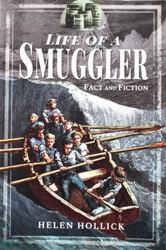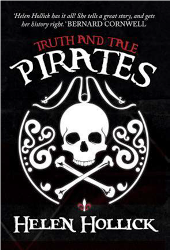 Pirates and Privateers Pirates and Privateers
The History of Maritime
Piracy
Cindy Vallar, Editor
& Reviewer
P.O. Box 425,
Keller, TX 76244-0425
    
Books for Adults ~ History: Piracy
History: Maritime
Life
of a Smuggler
Pirates

Life of a Smuggler: Fact and
Fiction
by Helen Hollick
Pen & Sword, 2019, ISBN 978-1-52672-713-8, US $24.95
/ UK £14.99
Smugglers.
The word conjures up romantic images, but who were
they and is what we know real or fictional? This
query is the one Hollick attempts to answer in Life
of a Smuggler. She opens by defining the word
and explaining the conditions that give rise to
these elusive men and women. Chapter one also
examines the origins of the word, as well as the
terms smugglers use when referring to themselves.
She primarily focuses on historical smuggling to the
mid-1700s, but also includes tidbits on later
periods and present-day operations.
Subsequent chapters answer the main questions of
when, why, and who. The main goal of the smuggler is
to bring goods of interest to the populace into the
country without paying taxes to the government. The
first such tariffs (on wine) appeared in
10th-century England. Hollick also looks at other
reasons for avoiding these taxes, the risks, the
participants, the language of smuggling, and the
switch from individuals to organized gangs. Equally
important is the chapter on the law and incentives,
or the lack thereof, that help and hinder the
revenue men.
After a discussion of the Battle of Sidley Green,
readers learn about how smuggling works, what items
are smuggled, and various tricks of the trade. Among
the names of individuals whom Hollick mentions is
Thomas Jefferson, who participated in smuggling when
serving as Minister to France. She also talks about
punishments, including amputation, and which came
first, the teacup or the teapot.
Four chapters are devoted to where English smugglers
ply their trade, dividing the country into the West
Country, the South-East, the East Coast, and the
countries that comprise the United Kingdom. A fifth
chapter looks at smuggling in the New World.
The final chapters address the factuality of inns
often referred to as “Smuggler’s Rest”; the
punishments smugglers face if caught; where
fictional authors hit the mark and where they don’t
in adhering to the facts; how smuggling today
differs from that of the past; and why we admire
smugglers.
Hollick intersperses “Little Known Facts” throughout
the book, although rather than placing these in
sidebars, the publisher opted to place these within
the main text. This tends to interrupt the flow of
the narrative and, at times, these highlights
contain the same information as the main text,
making for repetitive reading. Black-&-white
photographs are scattered throughout the book, and
the book includes a bibliography and further reading
list.
Readers seeking more in-depth histories on smuggling
would do better to read Richard Platt’s Smuggling
in the British Isles, Gavin D. Smith’s The
Scottish Smuggler, or Alan L. Karras’s Smuggling:
Contraband and Corruption in World History.
Those who desire just an enlightening and
entertaining introduction to the world and history
of the illegal importation of goods will enjoy
Hollick’s Life of a Smuggler.
Review
Copyright ©2019 Cindy Vallar

 Pirates:
Truth and Tales
Pirates:
Truth and Tales
by Helen Hollick
Amberley, 2017, ISBN 978-1-4456-5215-3, UK £20 /
US $29.95
Also available in other formats
    
One
might ask why we need another book that focuses
on the ‘Golden Age’ of piracy – you know the one
that takes place mostly in the Caribbean between
1713 and 1730 – but Hollick’s examination is far
more than simply about those swashbuckling
scoundrels. She sets the stage in her foreword,
summarizing several key points:
a. real
pirates versus their fictional counterparts;
b. society’s
changing attitudes toward them, as well as its
fascination with them;
c. definitions for
all the various terms that denote pirates;
d. piracy through
the ages; and
e. reality vs
romanticism.
To emphasize these
points her first chapter discusses “What We
Think We Know about Pirates,” while the second
focuses on “What We Ought to Know” and includes
the caveat “(Skip This Chapter If You Don’t Want
To Be Disillusioned).”
Within the 328 pages, she introduces us to a
wide array of pirates, including some who rarely
show up in other history books. Aside from the
usual suspects (in no particular order) – Henry
Jennings, Charles Vane, Samuel Bellamy, William
Dampier, Bartholomew Roberts, Blackbeard, Jack
Rackham, and William Kidd to name only a few –
we also meet Daniel Montbars, Jan Baert, and
Ignatius Pell (only a sampling). In addition,
you’ll find a handful of governors, including
Thomas Modyford, Alexander Spotswood, and Woodes
Rogers. There are chapters on the 1715 wreck of
the Spanish treasure fleet, medicine, ships,
weaponry, clothing, and safe havens, not to
mention interesting tidbits like the pirate
plunder that funds a college.
Don’t fear though! Women get a fair shake, too.
In addition to Anne Bonny and Mary Read, you’ll
learn about Jeanne de Clisson, Elise
Eskilsdotter, Ladies Mary and Elizabeth
Killigrew, Jacquotte Delahaye, Anne
Dieu-le-Veut, Jeanne Baret, Rachel Wall, and
Grace O’Malley. What you may not expect are the
other women who went to sea, such as Jeanne
Baret, Hannah Snell, and Mary Lacy. Or the fact
that a number of sea-songs concern females who
don male attire, join the Royal Navy, and then
are unmasked.
Nor is piracy the only topic explored within
this book, although these are all related in
some way. Since many pirates begin life either
as naval personnel or merchant marines, and
because they rarely leave behind detailed notes
on the mundane details of their daily lives,
Hollick discusses the tobacco and slave trades,
indenture, fidelity, tattooing, shipboard life
and navigation, and superstitions.
But wait! If you think that’s all, there’s still
more. After all, the subtitle of this book is
“Truth and Tales.” Not only does Hollick examine
fictional pirates in print and film, she talks
about writing from her own perspective as the
author of the Sea Witch adventures, which star
Captain Jesamiah Acorne, and she treats us to
excerpts from some of his piratical adventures,
as well as from Celia Reese’s Pirates!
and James L. Nelson’s The Only Life That
Mattered. Among the pirates of fiction
you’ll find Captains Hook and Sparrow, Long John
Silver, and Black Sails. As for Pirates
of the Caribbean, she also shares the impact
this series of movies has had on people’s lives.
While she shares what books and movies get right
and wrong, she also makes a great observation:
The
limitless realm of the imagination when
telling stories or writing fiction gives us
leave to plunder reality as blatantly as
those rascal scallywags plundered treasure.
(29)
In addition to all
this information, the book also includes a
timeline that begins in 1492 with Columbus’s
“discovery” of the Caribbean and Americas, and
ends with the death of Governor Spotswood in
1740. There are a Glossary of Terms – more
varied than often seen in nautical books – and
Nautical Measurements, which come before the
bibliography. There is no index, but scattered
throughout the book are color photographs with
interesting captions.
Another item that Hollick addresses pertains to
an often-asked question: What about a pirate
named so-and-so? To reinforce the fact that the
majority of pirates are simply unknown or merely
names in a document, she lists the crews of
Stede Bonnet, Blackbeard, Edward Lowe, George
Lowther, and Charles Vane. Most simply provide
the person’s name and the trial’s outcome – all
that is known about them. Only a few include
additional information.
The book consists of fifty-three chapters, each
two to thirteen pages long with the majority
falling somewhere in between. Her explanation of
the War of the Spanish Succession is concise and
easy to understand, one of the best I’ve
encountered. Much of the information on sea
shanties and tattooing, which predominantly
covers the time period after the golden age,
pertains to sailors in general. The same is true
about prisons and punishments, but all four
subjects are enlightening. On occasion, it’s
difficult to distinguish what’s more myth than
fact – good examples being Blackbeard’s many
wives and pirate flags – since there are no
footnotes or endnotes and myths are one topic
she doesn’t cover.
The statement that the skill of smuggling led to
the Revolutionary War and American Independence
is an oversimplification. Gory details are
explicit, but the book is geared toward adults
and mature readers, just like her Jesamiah
Acorne stories. There are enough misspelled
words – not including the differences in
spelling between British and American English –
and missing words that readers will notice. But
there is far more to recommend this book than
these minor problems.
Two chapters deserve special mention. The first
is highly helpful for those who wish to mimic
the way pirates speak on Talk Like a Pirate Day.
Hollick lives in the West Country, the region
where many seamen and pirates hailed from in the
past, so she offers her expertise so you can
learn some Devonish and speak it with a West
Country accent.
At least for me, the most intriguing chapter
concerns the real identity of Captain Charles
Johnson, the mysterious author who wrote A
General History of the Pyrates. She talks
about the two current likely candidates,
Nathaniel Mist and Daniel Defoe, and provides
plausible reasons why neither choice is
convincing. She puts forth her own contender –
and no, I cannot even be tortured into sharing
who that person is – which makes perfect sense,
even if there’s no hard evidence to support this
possibility. Even the reason for using the
pseudonym of Charles Johnson works.
Don’t be fooled. This pirate book is unlike any
other one. It resembles a scavenger hunt, and
you’re never quite certain where the trail will
lead next. Pirates is entertaining and
enlightening, with a good mix of facts and
fiction. At times tongue-in-cheek, Hollick’s
narrative holds your interest and keeps the
pages turning. The inclusion of details outside
the narrower scope of piracy provides a global
perspective, rather than simply viewing the
golden age marauders in isolation. Two
additional strengths are the inclusion of
lesser-known facts and general information that
can’t be found in other piratical volumes. The
questions she poses make you think and question
what you’ve read in other books on piracy.
But this book may not be for everyone. Those who
seek serious pirate history will probably want
to look elsewhere. Pirates is geared
toward readers seeking general information
spiced with an entertaining cornucopia of fact
and fiction that makes the book a tremendous
resource for a pirate trivia game.
Review Copyright ©2017 Cindy
Vallar
Reviews
of Helen Hollick's novels


Click to contact me
Background image compliments
of Anke's Graphics |


